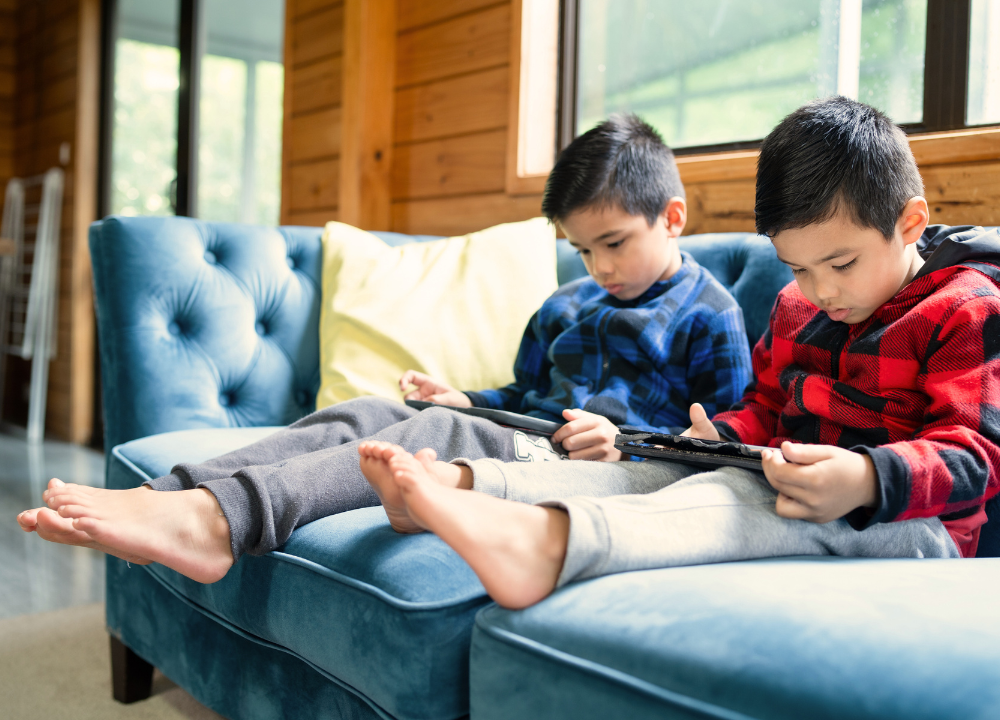Do you find yourself constantly battling over screen time or wondering if your child’s obsession with video games, YouTube, or social media is more than “just a phase”? Problematic Interactive Media Use (PIMU) is a growing concern among families of kids and teens, and we are answering some frequently asked questions to help you understand what’s typical, what’s not, and how to support your child in developing a healthier relationship with screens.
What are some of the key differences between a healthy interest in screens and signs of problematic use?
A healthy interest in screens typically involves a child who enjoys video games, shows, or online activities but can transition to other aspects of life, such as school, family meals, and outdoor play, without experiencing significant distress.
In contrast, problematic interactive media use begins to show when screen time displaces key areas of life, including sleep, nutrition, academics, friendships, and emotional well-being. A red flag is when kids continue to use screens even when it is causing negative consequences, like failing grades, irritability, or withdrawal from offline activities.
Why are certain types of digital media so compelling or even addictive for kids?
Digital media platforms are designed to trigger a dopamine response in the brain, the “feel-good” chemical. Fast-paced visuals, constant rewards, social interaction, and personalized content create a feedback loop that keeps kids engaged, and for some children, especially those with ADHD, autism, anxiety, or depression, this kind of stimulation can be especially captivating and harder to self-regulate around.
What’s happening in a child’s brain when they’re using screens for extended periods?
Extended screen time activates the brain’s reward system, particularly the dopamine pathway. Over time, the brain begins to crave this stimulation, leading to increased tolerance and difficulty disengaging. Long-term, this can disrupt the brain’s ability to manage frustration, delay gratification, and engage in creative or problem-solving tasks – all of which are still developing during childhood and adolescence.
Warning Signs of PIMU
Some common warning signs that a child’s screen use might be impacting their emotional, social, or physical well-being include:
- Declining academic performance, which is often the first sign
- Sleep disturbances or staying up late to use devices
- Increased irritability or mood swings when not allowed screen access
- Avoidance of social interaction or offline activities
- Poor nutrition, including skipping meals or distracted eating
- Complaints of headaches or eye strain
- Conflict at home around screen limits
How can parents set boundaries around screen time that are both developmentally appropriate and realistic for everyday life?
In childhood, focus on clear rules, limited access, and modeling healthy habits. As kids grow into adolescence, shift toward earned independence, open communication, and agreed-upon expectations around core responsibilities like sleep, school, and social interaction. Prioritize the quality of media use over just counting minutes, and involve kids in co-creating rules that make sense for your family.
When setting boundaries around screen time, we recommend using the 5 M’s of Digital Wellness:
- Model healthy habits
- Mentor by talking about screen use
- Monitor content and behavior
- Make Memories together offline
- Support Mastery by encouraging non-digital skills
What should a parent do if screen time battles are escalating or feel out of control?
If screen time is a daily struggle, it’s time to zoom out. Take a look at what screens may be displacing in your child’s life, whether it is sleep, school, social time, or other important aspects. Begin with open, nonjudgmental conversations and involve your child in finding a better balance. If needed, consider support from professionals who specialize in “media use therapy,” which can include cognitive-behavioral therapy, family coaching, or skill-building around self-regulation and communication.
How can families work together to create a healthier relationship with technology?
To create a healthier relationship with technology without constant conflict, we recommend approaching screen use as a shared family issue, not just a child problem. Emphasize open and empathetic communication and set collaborative expectations. Focus on educating kids about the social and functional aspects of digital media, not just restricting them. Use family routines, co-viewing, and active engagement to help kids feel seen, supported, and guided rather than just monitored.
For any further questions and additional support, register for our FREE expert-led seminar “Is My Kid Addicted to Screens? Understanding Problematic Interactive Media Use” on Monday, June 2, 2025 at 7:30 pm or contact our team at Puzzle Pieces today. We are here to support your child and your family through these challenges!

